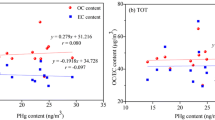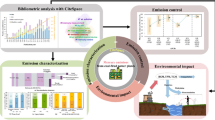Abstract
Coal combustion is a dominant source of Hg in atmosphere and is believed to be responsible for increases of atmospheric Hg since industrial revolution. In this study, we compared characteristics of different Hg species emitted from combustion of different types of coal in air and oxygen-enriched environment. Total Hg emissions from coal combustion increased significantly with increase of combustion temperature and the majority of emitted Hg existed in the form of Hg0. Total Hg emissions were 8.61 (5.38–16.48) ng/g (average and range) at 500 °C, while increased to 18.65 (6.49–40.38) ng/g at 900 °C. After burning at high temperatures, the higher percentage of reactive Hg species was observed in the flue gases, which was probably caused by promotion of Hg0 oxidation due to the higher flue gas temperature. Compared with air environment, more Hg (3.00–17.96 ng/g higher than air at 900 °C) was remained in ashes, and the percentage of reactive Hg in flue gases increased by 193%–826% at 900 °C under O2/CO2, which is beneficial for reduction of Hg emissions from coal combustion.




Similar content being viewed by others
References
Anheden M, Yan J, Smedt GD (2005) Denitrogenation (or oxyfuel concepts). Oil Gas Sci Technol 60:485–495
Bu X, Zhang H, Lv G et al (2018) Comparison of reactive gaseous mercury collection by different sampling methods in a laboratory test and field monitoring. Environ Sci Technol Lett 5:600–607
Buhre BJP, Elliott LK, Sheng CD et al (2005) Oxy-fuel combustion technology for coal-fired power generation. Prog Energy Combust Sci 31:283–307
Chen B, Li JS, Chen GQ et al (2017) China's energy-related mercury emissions: characteristics, impact of trade and mitigation policies. J Clean Prod 141:1259–1266
Galbreath KC, Zygarlicke CJ (1996) Mercury speciation in coal combustion and gasification flue gases. Environ Sci Technol 30: 2421–26
Galbreath KC, Zygarlicke CJ (2000) Mercury transformations in coal combustion flue gas. Fuel Process Technol 65–66:289–310
Giang A, Stokes LC, Streets DG et al (2015) Impacts of the minamata convention on mercury emissions and global deposition from coal-fired power generation in Asia. Environ Sci Technol 49:5326–5335
Guo J, Liu Z, Huang X et al (2017) Experimental and numerical investigations on oxy-coal combustion in a 35MW large pilot boiler. Fuel 187:315–327
Hecht ES, Shaddix CR, Geier M et al (2012) Effect of CO2 and steam gasification reactions on the oxy-combustion of pulverized coal char. Combust Flame 159:3437–3447
Jaffe D, Prestbo E, Swartzendruber P et al (2005) Export of atmospheric mercury from Asia. Atmos Environ 39:3029–3038
Jin Y, Andersson H, Zhang S (2016) Air pollution control policies in China: a retrospective and prospects. Int J Environ Res Public Health 13:1219
Koornneef J, Ramirez A, Harmelen TV et al (2010) The impact of CO capture in the power and heat sector on the emission of SO, NO, particulate matter, volatile organic compounds and NH in the European Union. Atmos Environ 44:1369–1385
Nuria FM, Antonia LA, Mercedes DS et al (2014) Effect of oxy-combustion flue gas on mercury oxidation. Environ Sci Technol 48:7164
Preciado I, Young T, Silcox G (2014) Mercury Oxidation by halogens under air- and oxygen-fired conditions. Energy Fuels 28:1255–1261
Roesler JF, Yetter RA, Dryer FL (1995) Kinetic interactions of CO, NOx, and HCI emissions in postcombustion gases. Combust Flame 100:495–504
Selin NE (2010) Global biogeochemical cycling of mercury: a review. Annu Rev Environ Resour 34:43–63
Senior CL, Sarofim AF, Zeng T et al (2000) Gas-phase transformations of mercury in coal-fired power plants. Fuel Process Technol 63:197–213
Sliger RN, Kramlich JC, Marinov NM (2000) Towards the development of a chemical kinetic model for the homogeneous oxidation of mercury by chlorine species. Fuel Process Technol 65–66:423–438
Spörl R, Belo L, Shah K, R. et al (2014) Mercury Emissions and removal by ash in coal-fired oxy-fuel combustion. Energy Fuels 28(1):123–135
Srivastava RK, Hutson N, Martin B et al (2006) Control of mercury emissions from coal-fired electric utility boilers. Environ Sci Technol 40:1385–1393
Streets DG, Zhang Q, Wu Y (2009) Projections of global mercury emissions in 2050. Environ Sci Technol 43:2983–2988
Streets DG, Horowitz HM, Lu Z et al (2019) Global and regional trends in mercury emissions and concentrations, 2010–2015. Atmos Environ 201:417–427
Sundseth K, Pacyna J, Pacyna E et al (2017) Global sources and pathways of mercury in the context of human health. Int J Environ Res Public Health 14:105
Tong Y, Eichhorst T, Olson MR et al (2013) Atmospheric photolytic reduction of Hg(II) in dry aerosols. Environ Sci Process Impacts 15:1883–1888
Tong Y, Eichhorst T, Olson MR et al (2014) Comparison of heterogeneous photolytic reduction of Hg(II) in the coal fly ashes and synthetic aerosols. Atmos Res 138:324–329
United Nations Environment Programme (UNEP) (2013) Minamata convention on mercury. UNEP Chemicals Branch, Geneva
Wang H, Duan Y, and Mao Y (2013) Mercury speciation in air-coal and oxy-coal combustion. In: Qi H, Zhao B (eds) Cleaner combustion and sustainable world. Springer, Berlin Heidelberg, pp 427–32
Wang H (2016) Mechanism studies on mercury speciation transformation in O2/CO2 fluidized bed coal combustion flue gas. Southeast University, Nanjing
Wang SX, Zhang L, Li GH, et al. (2010) Mercury emission and speciation of coal-fired power plants in China. Atmos Chem Phys 10: 1183–92
Wang S, Zhang L, Wang L et al (2014) A review of atmospheric mercury emissions, pollution and control in China. Front Environ Sci Eng 8:631–649
Wu H, Liu H, Wang Q et al (2013) Experimental study of homogeneous mercury oxidation under O2/CO2 atmosphere. Proc Combust Inst 34:2847–2854
Wu Q, Wang S, Li G et al (2016) Temporal trend and spatial distribution of speciated atmospheric mercury emissions in China during 1978–2014. Environ Sci Technol 50:13428–13435
Xu M, Qiao Y, Zheng C et al (2003) Modeling of homogeneous mercury speciation using detailed chemical kinetics. Combust Flame 132:208–218
Zhang L, Daukoru M, Torkamani S et al (2013) Measurements of mercury speciation and fine particle size distribution on combustion of China coal seams. Fuel 104:732–738
Zhang Y, Yang J, Yu X et al (2017) Migration and emission characteristics of Hg in coal-fired power plant of China with ultra low emission air pollution control devices. Fuel Process Technol 158:272–280
Acknowledgements
This study was funded by the National Natural Science Foundation of China (41630748, 41501517 and 41671492) and the Natural Science Foundation of Tianjin (Grant #16JCQNJC08300).
Author information
Authors and Affiliations
Corresponding author
Electronic supplementary material
Below is the link to the electronic supplementary material.
Rights and permissions
About this article
Cite this article
Sun, Y., Lv, G., Zhang, H. et al. Characteristics of Speciated Mercury Emissions from Coal Combustion in Air and Oxygen-Enriched Environment. Bull Environ Contam Toxicol 102, 695–700 (2019). https://doi.org/10.1007/s00128-019-02626-w
Received:
Accepted:
Published:
Issue Date:
DOI: https://doi.org/10.1007/s00128-019-02626-w




